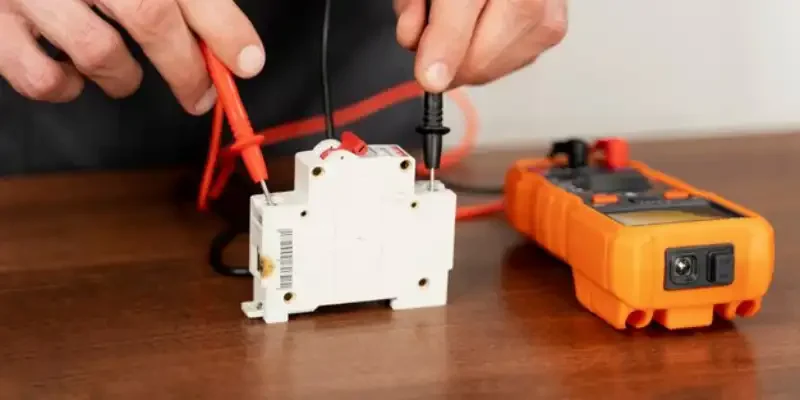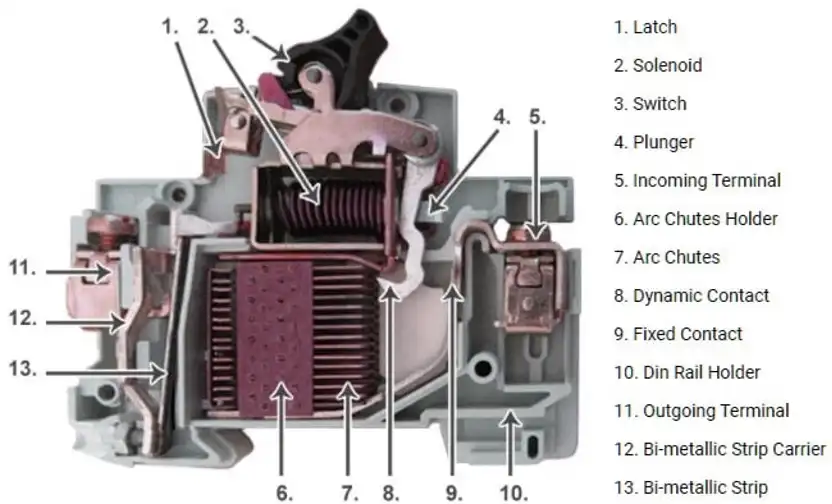У цій статті ми обговоримо відмінності між ПЗВ (пристроєм захисного відключення) і ПЗВ (мініатюрним автоматичним вимикачем). Ми пояснюємо їхні принципи роботи, типи та відповідаємо на деякі поширені запитання щодо цих важливих пристроїв електробезпеки.
I. Що таке ПЗВ (пристрій захисного відключення)?
Пристрій захисного відключення (ПЗВ) - це пристрій електробезпеки, призначений для запобігання ураження електричним струмом і зниження ризику виникнення пожеж. Він працює шляхом виявлення дисбалансу електричного струму, що протікає через ланцюг, зокрема, коли струм, що протікає в провіднику під напругою, не дорівнює струму, що повертається через нульовий провідник. При виявленні дисбалансу, що вказує на витік потенціалу на землю, ПЗВ швидко відключає ланцюг, як правило, протягом 30 мілісекунд, запобігаючи таким чином серйозним травмам або пошкодженням.
A. Як працює УЗО
ПЗВ працює за принципом балансу струму. Він безперервно контролює електричний струм у ланцюзі за допомогою диференціального трансформатора струму. За нормальних умов струм, що надходить через провід під напругою, повинен дорівнювати струму, що повертається через нульовий провід. Якщо виникає несправність - наприклад, людина торкається дроту під напругою або пошкоджений прилад спричиняє витік струму - ПЗВ виявляє цей дисбаланс і спрацьовує, відключаючи електропостачання. Така швидка реакція має вирішальне значення для мінімізації ризику ураження електричним струмом або пожежі, спричиненої несправною проводкою або приладами.
B. Типи ПЗВ
ПЗВ бувають різних форм, кожна з яких підходить для різних застосувань:
- УЗО для розеток: Вони інтегровані в певні розетки і забезпечують захист лише підключених до них пристроїв. Вони особливо корисні там, де використовується портативне обладнання, наприклад, на вулиці.
- Полагодили УЗО: Стаціонарні ПЗВ, що встановлюються в електроприймачі (запобіжники), захищають цілі ланцюги або групи ланцюгів. Вони забезпечують комплексний захист усіх підключених пристроїв і електропроводки, що робить їх ідеальним рішенням для житлових і комерційних установок.
- Переносні УЗО: Ці пристрої підключаються до стандартних розеток і дозволяють підключати до них електроприлади. Вони корисні для тимчасових установок або використання на вулиці, забезпечуючи захист, коли стаціонарні або розеткові ПЗВ недоступні.
II. Що таке ПЗВ (мініатюрний автоматичний вимикач)?
A. Визначення та основні функції
Мініатюрний автоматичний вимикач (ПЗВ) - це електромеханічний пристрій, призначений для автоматичного відключення електричного кола під час аномальних умов, таких як перевантаження або коротке замикання. На відміну від традиційних запобіжників, які необхідно замінювати після перегорання, ПЗВ можна скидати і використовувати повторно, що робить їх більш ефективним і надійним вибором для захисту ланцюга в низьковольтних електричних системах.
Ось так виглядає MCB
B. Компоненти МЦБ
ММС зазвичай складається з наступних компонентів:
- Вхідний термінал
- Вихідний термінал
- Тримач DIN-рейки
- Тримач дугових жолобів
- Дугові жолоби
- Фіксований контакт
- Динамічний контакт
- Біметалічний тримач для стрічки
- Біметалічна смуга
- Клямка.
- Плунжер
- Електромагніт
- Перемикач
C. Як працює MCB
ПЗВ працює, відстежуючи струм, що протікає через ланцюг. Він використовує два основні механізми для відключення:
- Термічне спрацьовування: Це біметалева смужка, яка згинається при нагріванні надмірним струмом. Коли вона достатньо прогинається, спрацьовує механізм засувки, який розмикає ланцюг.
- Магнітна пастка: У разі короткого замикання раптовий сплеск струму створює сильне магнітне поле, яке тягне плунжер, миттєво розриваючи ланцюг.
Разом ці механізми дозволяють MCB швидко реагувати на різні типи електричних несправностей, забезпечуючи безпеку, запобігаючи перегріванню та потенційній небезпеці пожежі.
D. Типи МЦП
MCB класифікуються на основі кількості полюсів, які вони містять:
- Однополюсник: Використовується для однофазних ланцюгів, захищаючи один провід під напругою.
- Подвійний полюс: Забезпечує захист як фазних, так і нульових проводів в однофазних колах.
- Потрійний полюс: Призначений для трифазних ланцюгів, захищає три дроти, що знаходяться під напругою (зазвичай позначаються як RYB).
- Чотири полюси: Подібний до триполюсного, але має додатковий полюс для захисту нейтралі, що робить його придатним для трифазних систем з нейтраллю.
III. Ключові відмінності між ОКР та МКБ
| Фактор | ПЗВ (пристрій захисного відключення) | MCB (мініатюрний автоматичний вимикач) |
|---|---|---|
| Функція | Захист від ураження електричним струмом | Захист від перевантаження по струму |
| Принцип роботи | Виявляє дисбаланс струму між струмоведучими та нульовими проводами | Відчуває струм, що протікає через ланцюг |
| Кнопка тестування | Має видиму кнопку тестування | Немає кнопки перевірки |
| Місцезнаходження | Після головного автоматичного вимикача | Перед УЗО |
| Додатки | Домівки, комерційні заклади для особистого захисту | Широкий спектр: побутові, комерційні, промислові |
| Рейтинги | Зазвичай від 16А до 125А | 0,5А до 125А |
| Типи | AC, A, B, F, S (на основі поточного типу) | A, B, C, D, K, Z (на основі характеристик поїздки) |
| Механізм захисту | Виявляє витік струму на землю | Захищає від перенапруги та короткого замикання |
| Чутливість | Зазвичай 30 мА для побутового використання | Залежить від номіналу ланцюга (від 6А до декількох сотень ампер) |
| Час відгуку | Швидкість (мілісекунди) | Повільніше (від секунд до хвилин) |
| Основне використання | Особистий захист (ураження електричним струмом) | Захист ланцюгів та обладнання |
ВНУТРІШНЬОВЕННЕ ВВЕДЕННЯ. Коли використовувати RCD на противагу MCB
A. Сценарії, що вимагають захисту ПЗВ
ПЗВ (пристрої захисного відключення) необхідні в ситуаціях, коли існує підвищений ризик ураження електричним струмом або коли обладнання може контактувати з водою. Типові сценарії включають
- Вологі ділянки: Ванні кімнати, кухні та зовнішні розетки, де можливий вплив води.
- Будівельні майданчики: Тимчасові установки, де електрообладнання використовується в непередбачуваних умовах.
- Сільське господарство: Місця з металевими конструкціями або обладнанням, які можуть створити шлях для витоку струму.
- Системи заземлення TT: В установках, де постачальник електроенергії та установка мають власне з'єднання із заземленням, ПЗВ часто потрібні для забезпечення безпеки від замикань на землю.
B. Ситуації, коли MCB є достатнім
Мініатюрні автоматичні вимикачі (MCB) підходять для загального захисту ланцюга в середовищах, де ризик ураження електричним струмом мінімальний. Поширені ситуації включають:
- Житлові схеми: Захист освітлення та силових ланцюгів у будинках, де електроприлади зазвичай не піддаються впливу вологи.
- Комерційні інсталяції: Захист ланцюгів в офісах і торгових приміщеннях, які не передбачають вологих умов.
- Загальний захист від перевантаження по струму: Ситуації, коли головним завданням є запобігання перевантажень і коротких замикань, а не ураження електричним струмом.
C. Поєднання ПЗВ та МКБ для комплексного захисту
Для оптимальної безпеки часто рекомендується комбінувати ПЗВ і ПЗВ. Така конфігурація дозволяє:
- Подвійний захист: ПЗВ захищають від перенапруг і коротких замикань, а УЗО - від струмів витоку на землю, забезпечуючи комплексний захист як від електричних несправностей, так і від потенційного ураження електричним струмом.
- Підвищена безпека в ризикованих зонах: У середовищах з високим електричним навантаженням і впливом вологи, наприклад, у майстернях або на відкритому повітрі, використання обох пристроїв гарантує усунення всіх потенційних небезпек.
- Дотримання Регламенту: Багато електротехнічних норм вимагають, щоб певні установки мали обидва типи захисту, особливо в комерційних або промислових умовах.
V. Переваги та обмеження
| Пристрій | Переваги | Обмеження |
|---|---|---|
| ПЗВ (пристрій захисного відключення) | Захист від ураження електричним струмом: Швидке відключення (25-40 мс) при виявленні дисбалансу струму | Неприємне спрацьовування: Може вимикатися без потреби через перехідні режими або несправні прилади |
| Універсальне застосування: Підходить для різних середовищ (житлових, комерційних, зовнішніх) | Обмежене виявлення несправностей: Не захищає від перевантажень або коротких замикань, якщо не поєднаний з MCB або RCBO | |
| Переносні варіанти: Пропонує гнучкість для тимчасових установок або місць, де немає стаціонарних установок ПЗВ | Не ефективний для певних несправностей: Не може виявити несправності нижче за течією або коли людина торкається як струмоведучих, так і нульових провідників | |
| MCB (мініатюрний автоматичний вимикач) | Захист від надструмів: Захищає ланцюги від перевантажень і коротких замикань | Не захищає від ураження електричним струмом: Не захищає від струмів витоку |
| З можливістю перезавантаження: Можна перезавантажити після спрацьовування, зручніше у використанні та економічніше, ніж запобіжники | Повільніший час спрацьовування: як правило, повільніший, ніж у ПЗВ, може не забезпечувати належний захист від безпосередньої небезпеки ураження електричним струмом | |
| Різноманітність номіналів: Доступні в різних номіналах для різних застосувань | Обмежена чутливість: Призначений для спрацьовування за вищих порогових значень струму, може не виявляти малі струми витоку |
VI. Поширені запитання
A. "Чи можна замінити ПЗВ на УЗО?"
Ні, ви не можете безпосередньо замінити ПЗВ (мініатюрний автоматичний вимикач) на ПЗВ (пристрій захисного відключення), оскільки вони виконують різні функції. ПЗВ захищає від перенапруги та короткого замикання, тоді як УЗО захищає від витоку струму на землю та ураження електричним струмом. Якщо вам потрібні обидва типи захисту, розгляньте можливість використання ПЗВ (пристрій захисного відключення із захистом від надмірного струму), який поєднує функції обох пристроїв в одному пристрої.
B. "Як часто я повинен перевіряти ПЗВ?"
Рекомендується тестувати ПЗВ щонайменше раз на три місяці. Більшість ПЗВ мають тестову кнопку, яка імітує несправність, дозволяючи користувачам перевірити, чи правильно спрацьовує пристрій. Регулярне тестування гарантує, що ПЗВ функціонує належним чином і забезпечить захист у разі потреби.
C. "Чи потрібен мені захист від ПЗВ і ПЗВ?"
Так, використання ПЗВ і ПЗВ забезпечує комплексний захист вашої електричної системи. ПЗВ захищає від перевантажень і коротких замикань, а ПЗВ - від ураження струмом витоку на землю. Така комбінація підвищує загальну безпеку, особливо в умовах, де присутні обидва ризики.
VII. Додаткові ресурси
A. Відповідні стандарти електробезпеки
- BS 7671: Правила улаштування електроустановок IET, також відомі як 18-те видання, визначають основні стандарти безпеки для електроустановок у Великій Британії. Вони охоплюють вимоги до УЗО, ПЗВ та інших захисних пристроїв.
- NEC (Національний електротехнічний кодекс): У США NEC надає рекомендації щодо безпечного електричного проектування, монтажу та перевірки, включаючи правила для ПЗВ (УЗО) та автоматичних вимикачів.
B. Професійні довідники електриків
- SBD Pro: Вичерпний довідник для пошуку місцевих електриків по всій території США, що містить списки найкращих підрядників з електромонтажних робіт.
- Рейтинговий каталог місцевих електриків: Цей британський каталог допомагає користувачам знайти незалежних, зареєстрованих електриків, які гарантують дотримання стандартів безпеки.
- Електробезпека понад усе: Ресурс для пошуку зареєстрованих електриків у Великобританії, які відповідають затвердженим урядом схемам.
- NECA (Національна асоціація електропідрядників): Надає каталог електропідрядників по всій території США, допомагаючи користувачам знайти кваліфікованих фахівців.
C. Провідні виробники ПЗВ та УЗО
ABB
- Спеціалізується на продуктах електрифікації та пропонує широкий асортимент автоматичних вимикачів.
- Веб-сайт: abb.com
Schneider Electric
- Відома своїми рішеннями в галузі енергоменеджменту та автоматизації, в тому числі різними пристроями захисту ланцюгів.
- Веб-сайт: se.com
Siemens
- Провідний виробник електротехнічного обладнання, в тому числі ПЗВ та УЗО, з інноваційними технологіями.
- Веб-сайт: siemens.com
Ітон
- Надає рішення з управління живленням і повний спектр пристроїв електричного захисту.
- Веб-сайт: eaton.com
Legrand
- Пропонує широкий асортимент електротехнічного обладнання, включаючи автоматичні вимикачі для житлового та комерційного використання.
- Веб-сайт: legrand.com
Hager Group
- Спеціалізується на рішеннях для розподілу електроенергії, включаючи ПЗВ та УЗО.
- Веб-сайт: hager.com
Rockwell Automation
- Надає рішення для промислової автоматизації, включаючи ряд пристроїв захисту ланцюгів.
- Веб-сайт: rockwellautomation.com
VIOX
- Китайський постачальник, що спеціалізується на низьковольтних електричних пристроях, включаючи автоматичні вимикачі.
- Веб-сайт: viox.com
VIII. Висновок
Розуміння відмінностей між ПЗВ і ПЗВ має вирішальне значення для забезпечення комплексної електробезпеки. У той час як ПЗВ захищають від перенапруги та короткого замикання, ПЗВ захищають від ураження електричним струмом та витоку струму на землю. Оптимальний захист часто передбачає використання обох пристроїв разом. Оскільки електричні системи розвиваються, важливо бути в курсі пристроїв і правил безпеки. Регулярне технічне обслуговування та професійні консультації є ключем до підтримання безпечного електричного середовища в житлових, комерційних або промислових приміщеннях. Вибравши правильні пристрої захисту, ви можете значно знизити ризик ураження електричним струмом і забезпечити безпеку людей та обладнання.




